Jigsaw puzzles from Japan
The Attic
Deleted puzzles by artist Masago Kimiya
This page shows puzzles that are no longer available, just for historical curiosity, and for completeness.
In some cases puzzles are reissued with a different code number: if you have the old code number from somewhere, this page should show you the replacement (which may still be available).
2000 pieces
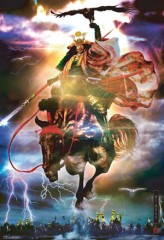 © Masago Kimiya 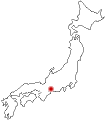
Nobunaga - battle of Okehazama (Masago)Oda Nobunaga (1534 – 1582), famous for his short temper and his military prowess, was the first of the three great warlords involved in the unification of 16th-century Japan, the others being his protégé Toyotomi Hideyoshi, and the first shogun, Tokugawa Ieyasu. This is a fantasy portrait of his first great victory, at the Battle of Okehazama (in present-day Nagoya). Further reading: start with the Wikipedia article on Nobunaga. Born in 1960 in Okayama, western Japan, Masago followed graduation from university in physics by working for the manga artist Terasawa Buichi, a pioneer of computer graphics in manga illustration. Masago went solo in 1989, and has made a career as an illustrator specialising in Chinese historical themes. His latest role is that of costume designer for the blockbuster movie "The Promise" (2006) by the Chinese director Chen Kaige. Masago is his family name, so he is also known as Kimiya Masago.
 Permanently unavailable Permanently unavailableA Beverly puzzle: 2000 pieces; 490 x 720 mm (19" x 28") Code: BS32503 (S32-503 on package) Retail price ¥3300 |
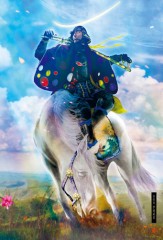 © Masago Kimiya Date Masamune, one-eyed dragon (Masago)A vivid portrayal of the famous warrior from northern Japan. Date (1567–1636) lost an eye to childhood illness, which gave him his nickname but did not stop him becoming one of the most powerful Daimyo, or regional rulers, of the time. Wikipedia article on Date Masamune
 Permanently unavailable Permanently unavailableA Beverly puzzle: 2000 pieces; 490 x 720 mm (19" x 28") Code: BS32504 (S32-504 on package) Retail price ¥3300 |
1000 pieces
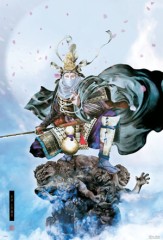 © Masago Kimiya Uesugi Kenshin, warrior god (Masago)The youthful Uesugi Kenshin tramples on a tangle of gargoyle figures in this fantastic rendering. Famed and feared as a warrior in 16th century Japan, his death poem also features on the front of the puzzle box (not on the puzzle itself). It is written in the Chinese style: "Forty Nine Years - one night's dream - a lifetime of prosperity - a cup of sake." 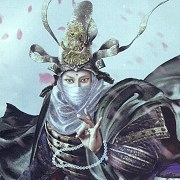 Born in 1960 in Okayama, western Japan, Masago followed graduation from university in physics by working for the manga artist Terasawa Buichi, a pioneer of computer graphics in manga illustration. Masago went solo in 1989, and has made a career as an illustrator specialising in Chinese historical themes. His latest role is that of costume designer for the blockbuster movie "The Promise" (2006) by the Chinese director Chen Kaige. Masago is his family name, so he is also known as Kimiya Masago.
 Permanently unavailable Permanently unavailableA Beverly puzzle: 1000 pieces; 490 x 720 mm (19" x 28") Code: B31348 (31-348 on package) Retail price ¥3300 |
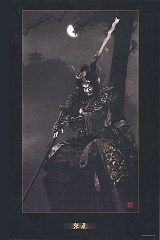 © Kimiya Masago / Kensin Zhang Fei (Masago)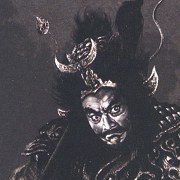 These sombre fantasy images by Masago Kimiya portray characters from the old Chinese story of the Three Kingdoms. This is based on the true history of the split in the Chinese empire around 1800 years ago, and the original record of events was written not long after, but the various later adaptations as novels have considerably embellished the true facts. The fourteenth-century Chinese novel, Romance of the Three Kingdoms, is the version best-known in English translation, but there have been a number of independent adaptations in Japanese, most notably by the novelist Yoshikawa Eiji (1892-1962), which has probably been a major influence on these images and the current round of role-playing games based on the story. Somewhat confusingly, Yoshikawa used the title of the original historical record (Sangokushi, or Sanguo-zhi in Chinese), instead of the "Romance" title of the Chinese novel. More background information: start with Sanguo-zhi at Wikipedia. The image is presented within a wide black margin, with the character's name in gold Chinese characters at the centre bottom, and the romanised (Pinyin) form underneath in dark grey. Don't be confused (as I was) by the legend 'ART OF WAR' in crimson in the lower left corner: this is not a reference to the (completely different) Chinese history book, but appears to be a brand name of the company licensing Masago's work. Born in 1960 in Okayama, western Japan, Masago followed graduation from university in physics by working for the manga artist Terasawa Buichi, a pioneer of computer graphics in manga illustration. Masago went solo in 1989, and has made a career as an illustratore specialising in Chinese historical themes. His latest role is that of costume designer for the blockbuster movie "The Promise" (2006) by the Chinese director Chen Kaige. Masago is his family name, so he is also known as Kimiya Masago.  Permanently unavailable Permanently unavailableAn Ensky (Artbox) puzzle: 1000 pieces; 500 x 750 mm (20" x 30") Code: N1028 (1000-28 on package) Retail price ¥3000 |
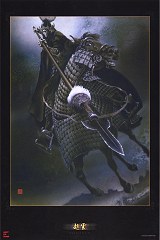 © Kimiya Masago / Kensin Zhao Yun (Masago)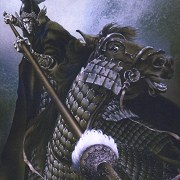 These sombre fantasy images by Masago Kimiya portray characters from the old Chinese story of the Three Kingdoms. This is based on the true history of the split in the Chinese empire around 1800 years ago, and the original record of events was written not long after, but the various later adaptations as novels have considerably embellished the true facts. The fourteenth-century Chinese novel, Romance of the Three Kingdoms, is the version best-known in English translation, but there have been a number of independent adaptations in Japanese, most notably by the novelist Yoshikawa Eiji (1892-1962), which has probably been a major influence on these images and the current round of role-playing games based on the story. Somewhat confusingly, Yoshikawa used the title of the original historical record (Sangokushi, or Sanguo-zhi in Chinese), instead of the "Romance" title of the Chinese novel. More background information: start with Sanguo-zhi at Wikipedia. The image is presented within a wide black margin, with the character's name in gold Chinese characters at the centre bottom, and the romanised (Pinyin) form underneath in dark grey. Don't be confused (as I was) by the legend 'ART OF WAR' in crimson in the lower left corner: this is not a reference to the (completely different) Chinese history book, but appears to be a brand name of the company licensing Masago's work. Born in 1960 in Okayama, western Japan, Masago followed graduation from university in physics by working for the manga artist Terasawa Buichi, a pioneer of computer graphics in manga illustration. Masago went solo in 1989, and has made a career as an illustratore specialising in Chinese historical themes. His latest role is that of costume designer for the blockbuster movie "The Promise" (2006) by the Chinese director Chen Kaige. Masago is his family name, so he is also known as Kimiya Masago.  Permanently unavailable Permanently unavailableAn Ensky (Artbox) puzzle: 1000 pieces; 500 x 750 mm (20" x 30") Code: N1029 (1000-29 on package) Retail price ¥3000 |
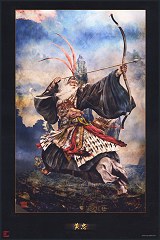 © Kimiya Masago / Kensin Huang Zhong (Masago)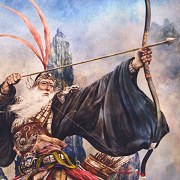 These sombre fantasy images by Masago Kimiya portray characters from the old Chinese story of the Three Kingdoms. This is based on the true history of the split in the Chinese empire around 1800 years ago, and the original record of events was written not long after, but the various later adaptations as novels have considerably embellished the true facts. The fourteenth-century Chinese novel, Romance of the Three Kingdoms, is the version best-known in English translation, but there have been a number of independent adaptations in Japanese, most notably by the novelist Yoshikawa Eiji (1892-1962), which has probably been a major influence on these images and the current round of role-playing games based on the story. Somewhat confusingly, Yoshikawa used the title of the original historical record (Sangokushi, or Sanguo-zhi in Chinese), instead of the "Romance" title of the Chinese novel. More background information: start with Sanguo-zhi at Wikipedia. The image is presented within a wide black margin, with the character's name in gold Chinese characters at the centre bottom, and the romanised (Pinyin) form underneath in dark grey. Don't be confused (as I was) by the legend 'ART OF WAR' in crimson in the lower left corner: this is not a reference to the (completely different) Chinese history book, but appears to be a brand name of the company licensing Masago's work. Born in 1960 in Okayama, western Japan, Masago followed graduation from university in physics by working for the manga artist Terasawa Buichi, a pioneer of computer graphics in manga illustration. Masago went solo in 1989, and has made a career as an illustratore specialising in Chinese historical themes. His latest role is that of costume designer for the blockbuster movie "The Promise" (2006) by the Chinese director Chen Kaige. Masago is his family name, so he is also known as Kimiya Masago.  Permanently unavailable Permanently unavailableAn Ensky (Artbox) puzzle: 1000 pieces; 500 x 750 mm (20" x 30") Code: N1030 (1000-30 on package) Retail price ¥3000 |
- 6 puzzles shown
- Explore the attics: complete list of deleted puzzles

 This puzzle has smaller pieces than the standard size.
This puzzle has smaller pieces than the standard size.